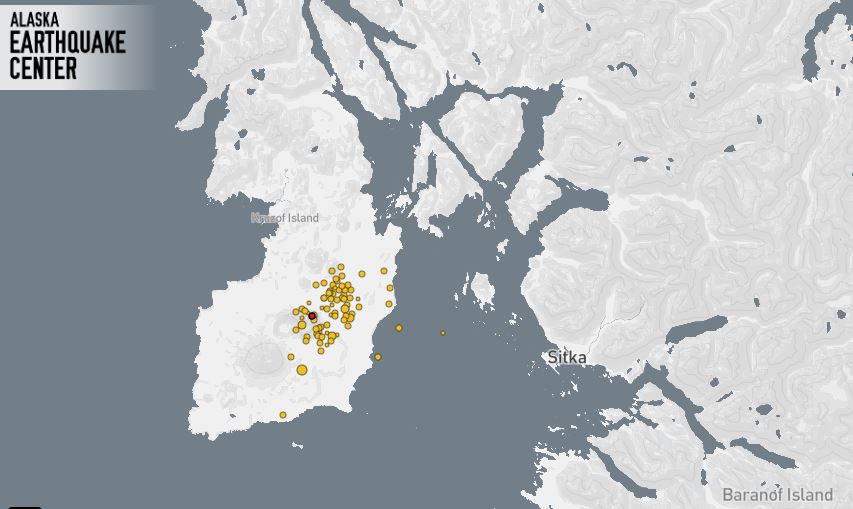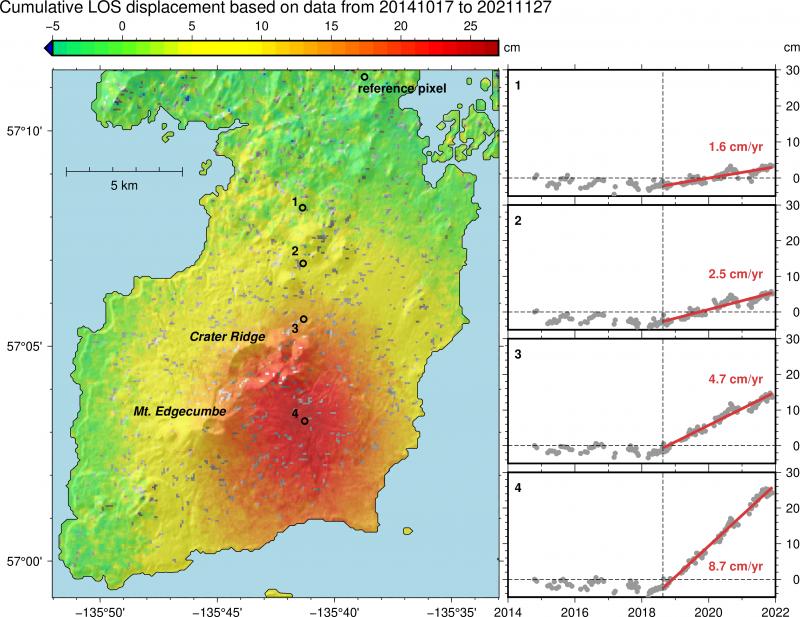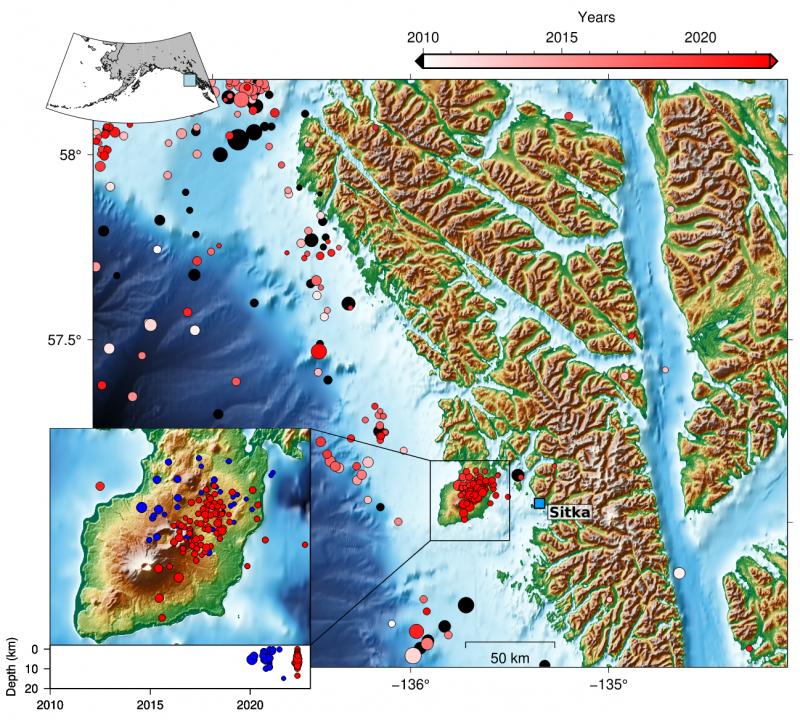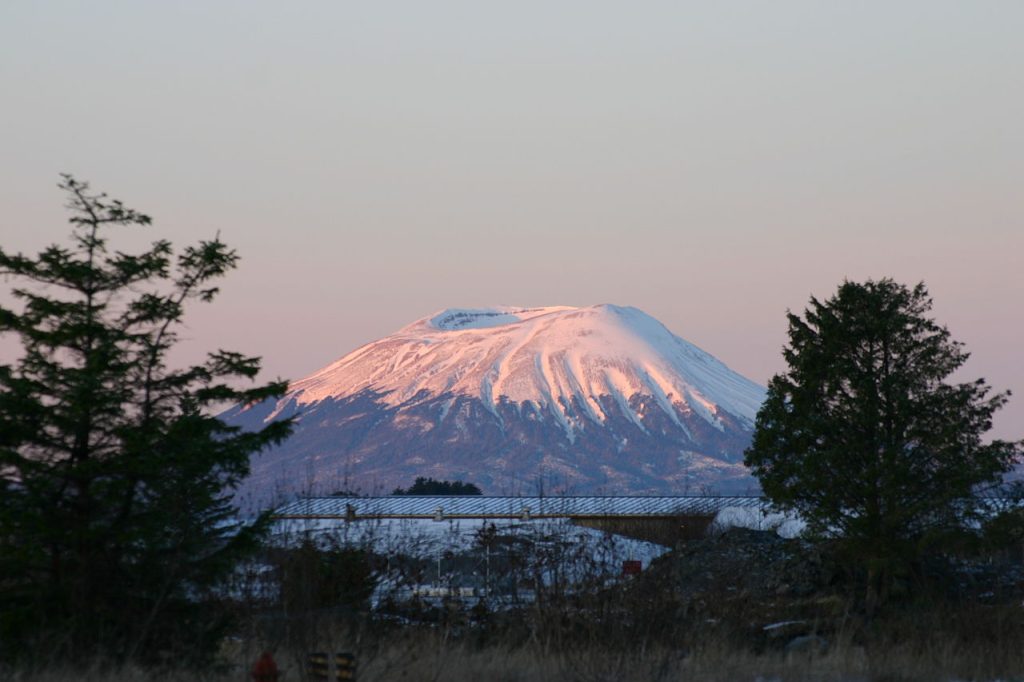A swarm of earthquakes was detected in the vicinity of Mount Edgecumbe volcano beginning on Monday, April 11, 2022.

There were hundreds of small quakes in the swarm, though the large majority were too small to locate. Over the past few days, earthquake activity has declined and is currently at background levels.
The recent swarm inspired an in-depth analysis of the last 7.5 years of ground deformation detectable with radar satellite data. Analysis of these data from recent years reveals a broad area, about 17 km (10.5 miles) in diameter, of surface uplift centered about 2.5 km (1.5 miles) to the east of Mt Edgecumbe.
Get your Professional digital Geiger Counter – Radiation Monitor right now!
This uplift began in August 2018 and has been continuing to the present at a rate of up to 8.7 cm/yr (3.4 in/yr) in the center of the deforming area. Deformation has been constant since 2018, and there has not been an increase with the recent earthquake activity. The total deformation since 2018 is about 27 cm (10.6 inches).

Retrospective analysis of earthquake data in the area of Mount Edgecumbe shows that a small number of earthquakes started occurring under the volcano in 2020.
Drink clean water at home… Get this filter now…
The recent earthquake activity that started on April 11 was unusual in having a greater number of events, however. The earthquakes detected under the volcano since 2020 are all M3.0 or smaller.
Note that only the largest of the earthquakes can be located by regional seismic networks; hundreds of very small additional events have been detected, but not located. A map showing earthquake locations in the area, including those occurring on regional faults, can be found here:

There have been no visual changes, surface temperature changes, or gas emissions observed.
Prognosis
The coincidence of earthquakes and ground deformation in time and location suggests that these signals are likely due to the movement of magma beneath Mount Edgecumbe, as opposed to tectonic activity.
Initial modeling of the deformation signal shows that it is consistent with an intrusion of new material (magma) at about 5 km (3.1 miles) below sea level. The earthquakes likely are caused by stresses in the crust due to this intrusion and the substantial uplift that it is causing.
Intrusions of new magma under volcanoes do not always result in volcanic eruptions. The deformation and earthquake activity at Edgecumbe may cease with no eruption occurring.
If the magma rises closer to the surface, this would lead to changes in the deformation pattern and an increase in earthquake activity. Therefore, it is very likely that if an eruption were to occur it would be preceded by additional signals that would allow advance warning.
Current monitoring
There is no local volcano monitoring network at Edgecumbe. The closest seismic station is in Sitka, 24 km (15 miles) to the east of the volcano and is operated by the National Tsunami Warning Center.
Updated satellite radar observations become available on weekly timescales.
Background
Mount Edgecumbe is a 976 m (3202 ft) high stratovolcano on Kruzof Island located 24 km (15 mi) west of Sitka, Alaska, and is part of a broader volcanic field of lava domes and craters on southern Kruzof Island and surrounding submarine vicinity.

There are no written observations of eruptions from the volcanic field; Tlingit oral history describes small eruptions from about 800 years ago.
Geologic investigations show that eruptions 13,000 to 14,500 years ago produced at least one widespread regional tephra (ash) layer around 1 m thick near Sitka and over 30 m thick on parts of Kruzof Island. Smaller eruptions occurred between 6,000 and 4,000 years ago.
Health Ranger Store: Buy Clean Food and Products to heal the world…
The primary hazards of past eruptions, and thus likely in future eruptions, have been volcanic ash emissions producing local and region ashfall and drifting ash clouds. Volcanic lahars (sediment-rich debris flows), pyroclastic flows (hot rock avalanches), and lava flows have also occurred on the flanks of Mount Edgecumbe. Mount Edgecumbe and the surrounding volcanic field lies within the Tongass National Forest. [AVO]
StrangeSounds.org is now running ad-free CLICK HERE TO SUPPORT MY WORK…
Food shortages and price hikes ahead. Get prepared with some products below Here some things to add to your disaster & preparedness kit:
- Protect your home and car with the best lightning and EMP shield available…
- Drink clean water at home… Get this filter now…
- Health Ranger Store: Buy Clean Food and Products to heal the world…
- Prepare your retirement by investing in GOLD, SILVER and other PRECIOUS METALS…
- You will ALWAYS have electricity with this portable SOLAR power station…
- Qfiles is another great site for alternative news and information…













